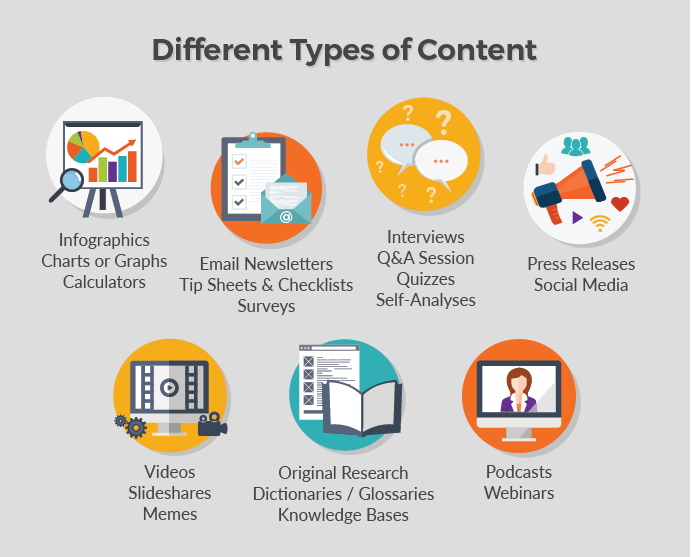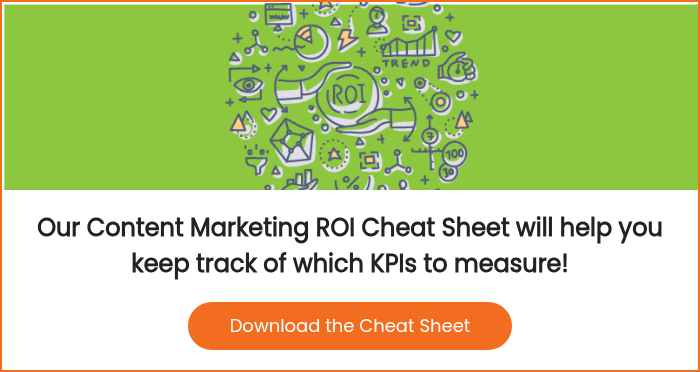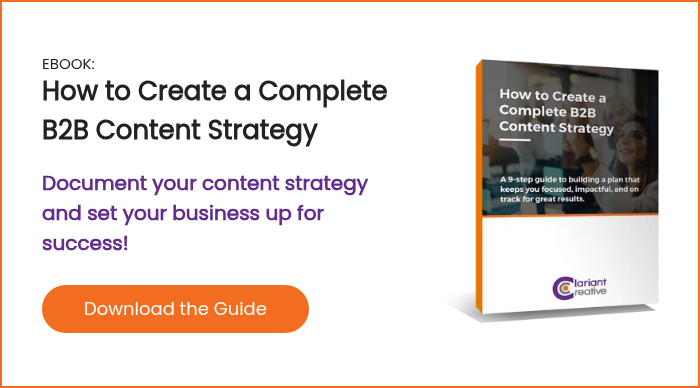The 9-Step Guide to a Complete B2B Content Strategy

All great content starts with a documented content strategy. But too often, businesses skip the planning stages and jump right into creating content. Although this might work for a little bit, it often leads to content that doesn’t have a focus, isn’t targeting your buyer personas or isn’t published on a consistent basis.
It’s one thing to know having a content strategy is important, but it’s quite another thing to know how to create one. So, if you’ve ever wondered how to create a content strategy for your business and what the latest B2B content marketing best practices are, we’ve got you covered.
Prefer to save this guide and read it later?

Table of Contents:

A content strategy is your vision for all your content marketing efforts – the ins and outs of how your content will be created, managed and eventually archived or updated.
Your strategy provides you with a roadmap to consistently create valuable, engaging and helpful content that attracts the right visitors, converts them into leads and closes them into customers.
Specifically, your content strategy should define:
- The people you’re targeting with your content
- What questions your strategy will answer for your audience
- The goals you hope to achieve with content marketing
- How your content will be unique from everything else out there
- The formats you’ll use when publishing content
- The channels where you’ll promote content
- How you’ll schedule and manage creation and publication
- How you’ll measure the success of your content marketing

A strategic plan gives your content purpose – a “why” – and serves as a roadmap for how you’ll achieve your content marketing goals.
But too often, businesses approach content marketing a lot like this:
Everyone on the marketing team agrees that content marketing is important, useful and a good idea for the business. But then the question remains: Who will manage creating the content? One of the team members (we’ll call him John) raises his hand and says he’ll give it a shot.
So, John goes back to his desk and spends a good part of the day writing a blog post. Once he’s finished, he shares the blog with the rest of the team. Everyone weighs in and makes suggestions on how to make it better. The next day, John spends a few hours making those edits. Now the blog post is ready to publish. Hooray!
Now, it’s onto the next blog, and John knows he’s going to spend at least half his day writing. But the company is also preparing for a super important trade show, and the marketing team needs all hands on deck to get everything ready. So, John puts the blog post on hold until next week.
The next week arrives, and Nancy is on vacation, which leaves John to cover for her and pick up some of the extra work – meaning he won’t have time to write the blog post this week.
And before you know it, several months go by without any more blogs being published.
Sound familiar?
It’s a common scenario for many businesses. The lack of a clear, documented content production strategy means you’re inefficient at best. At worst, you risk producing the wrong content (i.e. content that doesn’t help you achieve your business goals) or you’re not producing content at all.
Managing content is a challenge for many marketing teams. With so many moving pieces – from what to write about, to who will write it, to what to do after you hit “publish” – it’s easy for content creation to get lost in the shuffle of other marketing tasks.
What the data says about content marketing strategies
Although 72% of businesses view content as a core business strategy, only 45% feel they build subscribed audiences – the key to lasting customer relationships. And that may have something to do with the fact that only 41% of marketers have a documented strategy in place.
According to Content Marketing Institute (CMI), businesses with a documented content strategy are:
- More likely to consider themselves very or extremely successful at content marketing. 69% of businesses with a documented content strategy consider their organization to be among the top performers at content marketing.
Having a strategy in place is one thing, but is your strategy effective? 95% of the most successful marketers say they use metrics to measure content performance, 83% have KPIs associated with content, and 67% measure content marketing ROI.
The lesson? If you want to be more effective at content marketing, take the time to document your strategy and monitor results regularly.
- Less challenged creating long-term relationships with customers. The most successful B2B content marketers use their strategy to build loyalty with customers (84%), nurture subscribers and leads (83%), and generate sales revenue (75%).
Companies with a documented strategy found it easier overall to create content based on each stage of the customer journey and prioritize their audiences’ needs over a sales message.
- Able to justify a higher percentage of their marketing budget on content marketing. CMI found a correlation between effectiveness and the amount of budget allocated to content marketing.
The most effective B2B marketers allocate 1.5 times more to their content marketing budget than the average B2B marketer.
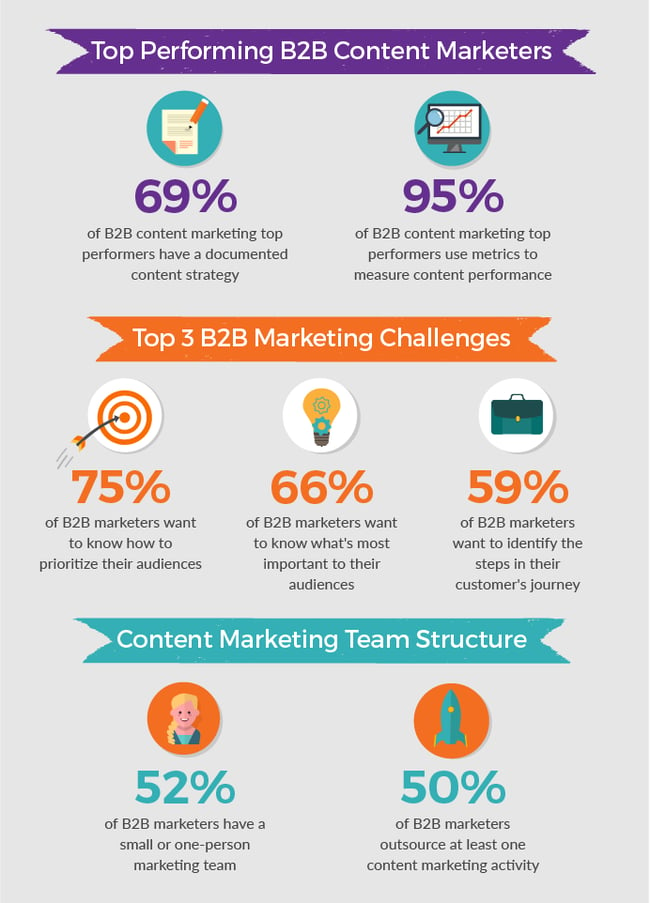
Additionally, having a documented content strategy helps businesses of all sizes by:
- Guiding you in determining the types of content to create. By having a documented strategy, you’ll be able to remain focused on your ideal buyers, which enables you to create content they’ll want to read.
- Allowing you to plan and allocate the resources you’ll need to create content. A content strategy lets you see the big picture of all your content needs and helps you determine whether you can accomplish the entire plan with the resources you have or whether you’ll need to adjust your priorities, hire additional staff or hire an inbound marketing agency.
- Keeping you on schedule. Content marketing is a long-term play that requires consistency to be successful. But it’s easy to lose steam after the first month or two when you don’t have a documented strategy in place. Defining your strategy helps you see what you have planned and keeps you on track.
- Keeping you goal-focused by clearly defining what success looks like. This will prevent you from throwing resources at something that has no impact on revenue.
Why Is B2B Content Strategy Especially Important
 Another great reason to create a content strategy is to make sure your targeting is accurate, which highlights one of the key differences between B2B and B2C marketing.
Another great reason to create a content strategy is to make sure your targeting is accurate, which highlights one of the key differences between B2B and B2C marketing.
Often, B2C is relatively straightforward from a targeting perspective. Content aimed to the customer speaks directly to the decision-maker, so your strategy is focused mainly on getting and keeping their attention long enough to convert.
But B2B is more complicated. There are no impulse buys when you’re asking a company to drop four, five, or even six figures on your products or services. Instead, the decision-maker usually relies on others in their organization to collect information and recommend vendors.
So, not only does your content need to be searchable and engaging enough to impress the information-gatherers, it also needs to speak to the person in the organization who has the power to make buying decisions.
And in general, these folks are busy. Your content has to be ultra-clear, ultra-precise, and ultra-targeted. This makes content strategy for B2B much more complex.
Don’t make the mistake of trying to make everything up as you go along. If you’re going to invest in content marketing, set yourself up for success by taking the time to document your content strategy upfront.

Your business has more competition than ever.
More than 40% of marketers planned to devote most of their time and budget to content marketing in 2020. For your business to be competitive, you need to have a content strategy in place.
Ready to get started creating your content strategy? Here are the steps you’ll need to take.
Step 1: Define your goals
 Setting goals is an important part of any content strategy. But goal setting is probably one of the hardest things a marketer must do. After all, you need to choose a goal that’s tough to achieve but isn’t so tough it’s impossible.
Setting goals is an important part of any content strategy. But goal setting is probably one of the hardest things a marketer must do. After all, you need to choose a goal that’s tough to achieve but isn’t so tough it’s impossible.
So, how do you strike that perfect balance and set goals that are achievable but still challenging? You set SMART goals, which means your goals are:
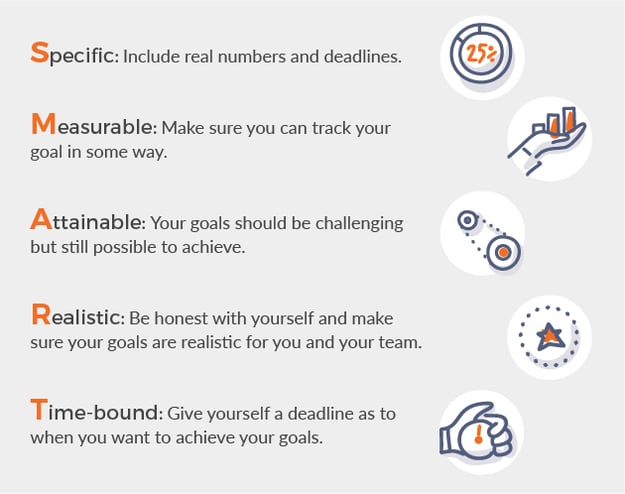
Examples of SMART goals include:
- We want to generate 50 new leads from our content marketing efforts between January 1 to March 31.
- We want to hit 5,000 visits from organic search in January.
- We want to rank number one in Google for the keyword “fraud protection” by the end of June.
Now that you know what SMART goals are and what they look like, here are seven tips that will help you create effective goals for your business:
- Specific
- Measurable
- Attainable
- Realistic
- Time-bound
1. Think about the big picture
Setting SMART goals is about breaking down goals into measurable pieces. At the beginning of the process – before you make sure it meets the SMART goal criteria – think about the big picture goal you’re trying to achieve.
2. Look at current data and trends
One of the most challenging parts of setting SMART goals is setting that specific number you want to work toward.
To help make the process easier, start by looking at your current data and trends. This will give you a better idea of where you are now, what’s achievable and how to make a plan for hitting your new goals.
3. Be realistic with your completion dates
While everyone would love to see huge growth in a short period of time, do you have the time and resources needed to complete your goals within the time frame you selected?
Remember: Be realistic about what you can achieve, but don’t give yourself too much time to get it done.
4. Write down your goals
Resist the urge to set goals in your head. Write everything down so you have a record of what goals you’re working toward and how you intend to achieve it. This helps ensure everyone on your team is on the same page and that they understand the goals and their purpose in your content strategy.
5. Plan for problems
In an ideal world, you’d set your SMART goals, everyone would start working toward those goals and you’d achieve them every single time. But as every marketer knows, nothing ever goes exactly according to plan.
Think through some of the possible challenges your marketing team may face trying to achieve the goals you’ve set, and find ways to prevent or resolve them before they even come up.
6. Track your progress
Don’t just set your goals and forget about them. At least once a month, take the time to track your progress. The data you’ll want to review depends on the goals you’ve set, but don’t overthink it.
For example, if your goal is to hit 10,000 visits from organic search in Q1 of next year, look at how much traffic is coming in from organic search every month.
Recording this data will help you see whether you’re on track to achieve your goals, but just as important, it’ll help you set better goals in the future.
7. Communicate with your team
As you continue to work toward your SMART goals, remember to communicate with the rest of the team. Let everyone know what challenges you’re experiencing and what milestones you’ve hit – and make sure everyone else on the team is comfortable doing the same.
Goal setting isn’t an easy process, and you’ll likely find yourself re-visiting and tweaking goals as you go. That’s okay. Your goals don’t need to be perfect the first time. The idea is to figure out where you want to go, get something down on paper and work toward it.
Step 2: Develop your buyer personas
 Before you start creating content, it’s important you understand the people you’re creating content for. And the best way to do this is to create buyer personas.
Before you start creating content, it’s important you understand the people you’re creating content for. And the best way to do this is to create buyer personas.
According to HubSpot: A buyer persona is “a semi-fictional representation of your ideal customer based on market research and real data about your existing customers”. When creating buyer personas, you’ll want to include information such as demographics, industry, job role, goals, challenges, decision making factors, where they go for information and more.
There are many reasons to create buyer personas for your business:
- They help drive your marketing and sales strategies
- They help you understand your customers and prospects better
- They make it easier for you to tailor your messaging, content, product development and services to the specific needs, goals, pain points and behaviors of your ideal customers
- They help get everyone in your organization on the same page about who you’re targeting
How to create buyer personas
To create strong buyer personas, we recommend you start by talking to people within your own company.
Talk to your sales reps, customer service reps and account managers – the people who are on the front lines dealing with customers every day. They’ve heard everything – their most pressing questions, their biggest challenges and what prevents them from making a purchase decision – and they’ll have a good sense of your ideal customer’s pain points and questions.
Ask your team questions that help you better understand the mindset of your buyers and prospects:
- What questions from prospects or customers do you encounter most often?
- What makes prospects or customers happiest? Why do you think that is?
- What frustrates prospects or customers? Why do you think that is?
- Who typically has influence over buying decisions within prospect and customer organizations? Are these the same people we normally speak to? If not, at what point, if any, do we speak to these decision-makers? What questions do they ask?
Not only will these internal interviews help you learn more about the questions and pain points your content needs to address, but they also let your team know they’re critical to the process of creating buyer personas. This gives everyone a stake in the game and ensures everyone is on the same page with your marketing efforts.
Once you’ve completed the internal interviews, it’s time to start interviewing your customers. Keep in mind, though, you’re not looking for testimonials. You’re looking for the thoughts and motivations that led them to find and choose your company.
This means you need to ask the right questions. Only scratch the surface, and you’ll end up with overly general personas that don’t give you a true picture of your ideal customer. Dig too deep, and you’ll get an overly specific profile that’s difficult to project across more than that one client.
The strategy behind a great buyer persona interview, then, is to make sure your questions touch upon several key areas including:
- Personal background
- Industry and business
- Job role
- Goals
- Challenges
- Decision making
- Objections
- Sources of information
For every persona you create, try to interview at least three to five people – although you may need to interview more. It all depends on how much you know about your persona to begin with and how much information you gather during your interviews.
A general rule to follow is this: When you’re able to start accurately predicting what your interviewee is going to say, it’s probably time to stop. Through your buyer persona interviews, you’re going to start noticing some patterns. And once you start expecting and predicting what your interviewee is going to say, that means you’ve interviewed enough people to find these patterns.
Depending on your business, you could have as few as one or two personas or as many as 10 to 20. But, three to five is usually a good place to start. Remember: You can always develop more personas later if needed.
Step 3: Map the buyer’s journey
 Given that most B2B buyers do more than half of their research online before ever reaching out to a company’s sales team, knowing what your prospects are searching for and what questions they have is critical to your content’s success.
Given that most B2B buyers do more than half of their research online before ever reaching out to a company’s sales team, knowing what your prospects are searching for and what questions they have is critical to your content’s success.
This is where mapping the buyer’s journey comes in. Mapping the buyer’s journey adds an extra layer to your buyer personas, helping you align your content with the questions a prospect has through each distinct stage of the buyer’s journey: awareness, consideration and decision.
| Awareness (top of the funnel) |
|
In the awareness stage, a buyer is experiencing and expressing symptoms of a problem, and they’re doing educational research to help them more clearly understand their problem. When creating content for the awareness stage, focus on the buyer’s pain points – not your product or brand. The goal is to educate your audience and answer their questions. Common awareness stage content includes blogs, ebooks, white papers, tip sheets, guides, infographics and slideshares. |
| Consideration (middle of the funnel) |
|
The buyer now has a clear idea of what their problem is, and they’re committed to researching and understanding all the available approaches to solve their problem. During this time, a buyer will also start to compare the different approaches they can take to solve their problem. When creating consideration stage content, focus on making it solutions-oriented. In other words, how can a specific solution make the buyer’s life easier or solve their problem? Common consideration stage content includes more technical blog posts, comparison white papers or e-books, webinars and product feature videos. |
| Decision (bottom of the funnel) |
|
In the decision stage, the buyer has decided on their solution strategy, and they’re compiling a list of all the products or vendors that can solve their problem. Ultimately, they’re doing research to make a final purchase decision. Now is the time to create content that’s brand-specific and focuses on your product or service. Common decision stage content includes case studies, testimonials, vendor/product/pricing comparisons, live demonstrations and free trials. |
As a buyer moves through each stage of the buyer’s journey, his or her questions and needs change. A good content strategy answers questions at every stage of the buyer’s journey and provides a roadmap for how you’ll do it.
But you don’t want a good content strategy. You want a great one. To make that happen, you take your knowledge of your most important buyer persona(s) and combine that with your knowledge of their buyer’s journey. That way, you’re always speaking to the right people, providing them with clear, helpful answers to every question they have, increasing their comfort and confidence in your business and improving the chances that they’ll buy from you.
Once you know who you’re talking to, you’ll need to determine how you talk to them.
Step 4: Determine your brand voice and tone
 Every successful brand has their own unique style and personality. Just take HubSpot, MailChimp and Buffer for example. Each of these companies operates in a similar market, but each has its own style that differentiates their approaches to content marketing.
Every successful brand has their own unique style and personality. Just take HubSpot, MailChimp and Buffer for example. Each of these companies operates in a similar market, but each has its own style that differentiates their approaches to content marketing.
And creating this memorable, distinct style all starts with voice and tone.
Voice and tone are the backbones of your brand’s personality and should never be an accident. Developing a strong voice and tone needs to be something you constantly work toward because consistency is memorable. Voice and tone help you create a powerful, unforgettable brand your audience will connect with.
Before we go any further, let’s take a step back and define voice and tone:
Voice:
This is your brand personality described in adjectives – the attributes that your ideal customer uses to describe you. Is your brand funny? Serious? Irreverent? Warm? Edgy? Voice should be consistent across all your marketing.
Tone:
This is how your brand sounds and how your brand personality manifests in a piece of content. Unlike voice, tone is dynamic and may change based on the buyer persona you’re targeting, the type of content you’re creating or the message you’re delivering. If you offer retail payment gateway services, for example, you might speak differently when creating a how-to guide for a small business than you would when writing a data sheet for an enterprise-level prospect.
Essentially, your brand has one voice but multiple tones that shape your voice in different content scenarios.
What if my tone doesn’t match my personas?
Always keep your buyer personas in mind when creating your brand voice and tone. For example, you may want to sound modern and fun, but maybe your existing personas respond to content that’s straightforward and professional.
This is where some tough decisions may come into play. Certain industries are going to find themselves within a somewhat narrowed range when it comes to voice and tone. Your business may be made up of wildly hilarious, irreverent hooligans (no disrespect intended – we love hooligans!), but if your target audience is financial services c-suite, you may need to examine how you can speak your audience’s language while still letting your authentic brand shine through.
However, don’t be afraid to nudge the boundaries a bit. The definition of “businesslike” has expanded considerably over the past decade or so, giving marketers the opportunity to show their brand’s personality, even in ultra-conservative industries.
Creating a content style guide
Once you’ve defined your brand voice and tone, it’s time to formalize it in a content style guide. A content style guide is a document that helps everyone in your organization understand who your brand is and how it’s expressed through copy and content. It doesn’t need to be fancy or elaborate, but it should be documented in some way so everyone can use it.
Need some inspiration? Check out the voice and tone section of MailChimp’s content style guide:
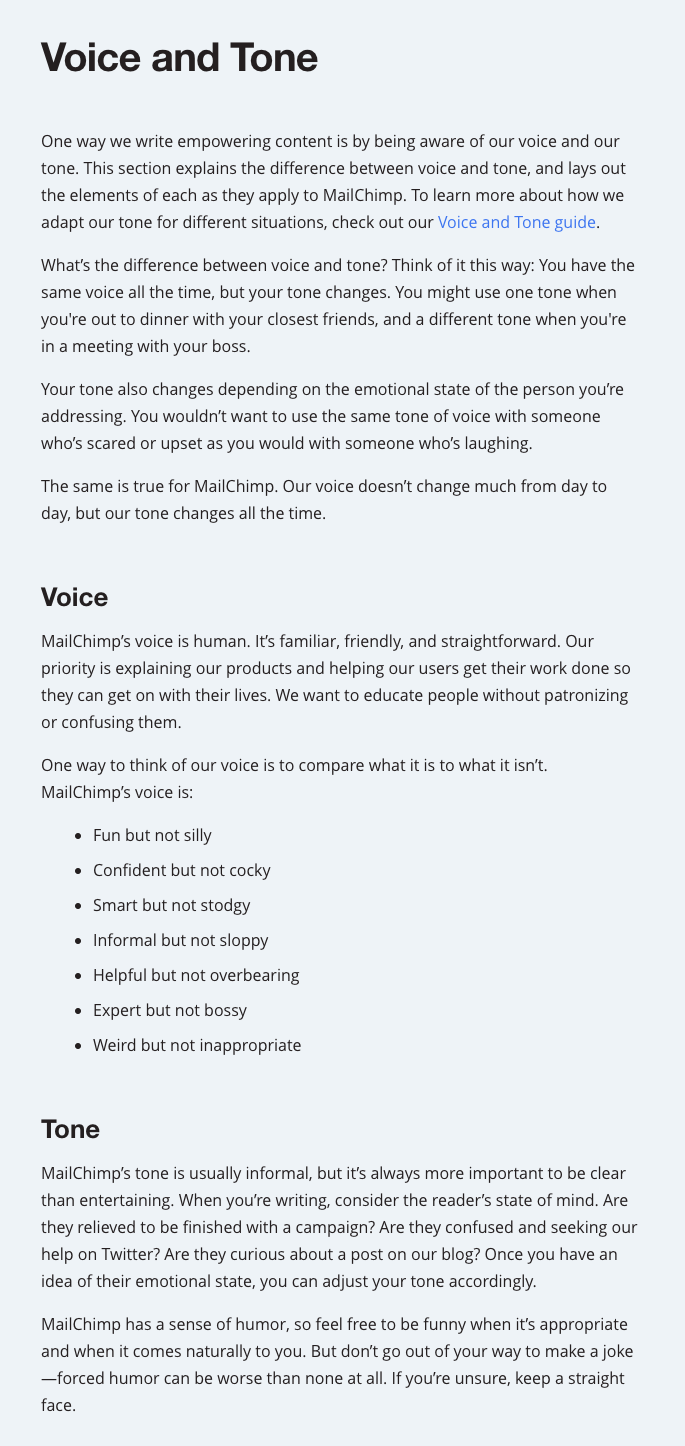
Step 5: Conduct a content audit
 An important – but often overlooked – step in creating your content marketing strategy is conducting a content audit, which is an in-depth look at the content you’ve already created.
An important – but often overlooked – step in creating your content marketing strategy is conducting a content audit, which is an in-depth look at the content you’ve already created.
It’s often tempting to skip this step. After all, why do you really need to take a look at the current content on your site? Isn’t it all just part of the past? Not quite. Analyzing your current content helps you:
- Learn what’s working and what your audience is responding to
- Learn what’s not working so you can do less of it in the future
- Find holes in the types of content you create and topics you cover
- Avoid duplicate content on your website
Now, you could spend a few hours looking through your site, reading some content and forming opinions based on what stood out to you. But a loosely structured content audit won’t give you the whole picture. To really understand the quality of the content on your website, you need to assess each page with a set of standard metrics.
Here are the four basic steps for conducting a content audit:
1. Take an inventory of your existing content
To start your content audit, take an inventory of the existing content on your website. You can do this manually if you have a small site or you can use a tool like Screaming Frog to pull the full list of URLs from your site.
2. Organize and tag your content
Once you have a list of all the URLs from your website, you’ll need to describe your existing content based on the following criteria:
- Topic
What is the content about? Does it talk about your product or service, or is it more educational?
Come up with a list of broad categories that summarize the topics you’ve covered in your content and assign each piece to a category or two. This will help you draw conclusions about what topics your audience is most interested in.
- Length
How long is the piece? And does the word count affect how it’s viewed and shared by your audience? Do your personas prefer longer, more comprehensive pieces of content, or do they prefer shorter pieces they can quickly digest?
- Buyer’s journey
What stage of the buyer’s journey does each piece of content fall into – awareness, consideration or decision?
- Tone
What’s the tone of each piece of content? Conversational? Professional? Persuasive? Come up with a few adjectives that describe the tone of your content pieces.
- Relevance
How relevant is a topic to what your business actually does? Does it talk about your audience’s pain points? Or is it something that’s only loosely relevant to your business? Create a scale and determine where each piece of content falls on that scale.
- Datedness
Some content is evergreen and lasts forever, while other content is tied to current events. Again, create a scale, and decide where each piece sits on that scale.
- SEO
Is the piece properly optimized for SEO? Does it have a designated keyword, meta description, title tag, headings throughout and image alt text? Write down each of these pieces and make a note if something is missing.
- Visual content
Does the post feature any additional content like embedded videos, imagery or an infographic?
3. Add success metrics
Now it’s time to add success metrics for each post. The metrics you’ll want to measure will vary based on the goals you’ve set for your content strategy, but here are a few to get you started:
- Page views
- Time on page
- Social shares
- Conversions
4. Analyze the data for patterns and gaps
Congratulations – the tedious part of conducting a content audit is done. Now for the fun part: analyzing the data!
As you sort through the data, look for trends. For example, are all your best-performing blogs about a specific topic? Are your highest converting blogs a certain length?
Don’t forget to identify the gaps in your content as well. Maybe you find that most of your content falls in the awareness stage of the buyer’s journey and that you don’t really have a ton of consideration or decision stage content. Or, you may find that you don’t have a lot of content on certain topics.
Conducting a content audit takes some time, but it’s well worth the effort – especially as you get ready to build out your strategy and brainstorm new content ideas.
Step 6: Brainstorm new content ideas
 Great content ideas are at the heart of any content strategy. Sometimes, though, finding the right ideas is a daunting task – but it doesn’t have to be.
Great content ideas are at the heart of any content strategy. Sometimes, though, finding the right ideas is a daunting task – but it doesn’t have to be.
Inspiration for new content ideas is everywhere. You just need to know where to look. Some ways to come up with new ideas include:
The swipe file
If you aren’t already keeping a folder of ideas, images, approaches, content pieces and technologies that inspire you, start now. Look to this file whenever you need inspiration for a new project.
A swipe file can take any form that works for you: a Dropbox or Google Drive folder, a bookmarks folder, email folder, app, Pinterest board, Trello card, Evernote, etc.
Brainstorming session
A successful brainstorming session can help you generate a ton of new content ideas. But the key is doing it right.
Here are a few tips to help you run a successful brainstorming session with your team:
- Keep the participants to a minimum. This isn’t to say you can’t have a 10-person brainstorming session. But, if you do, break up into groups of five or fewer for the initial brainstorming then report back to the group afterward.
- Involve the whole company. Sometimes, it’s helpful to include people who aren’t familiar with the project because they’ll come in with fresh ideas. Include everyone on your team – from marketers, designers and web developers to sales reps, account managers and executives.
- Keep the ideas open. When you first start a brainstorming session, no ideas are bad ideas. So, even if someone presents an idea that doesn’t sound like it would work, avoid saying “no” to their idea. Instead, find a way to recognize the validity of each idea and see if there’s a way you can incorporate it into your strategy.
- Record everything. If you’re doing the meeting virtually via a video chat, record the call. If you’re holding it in person, write every idea down on a whiteboard or piece of paper, and take a picture so everyone has access to it.
Competitive research
It’s important to read your competitors’ content on a regular basis and watch for what you think works and what doesn’t. We know it sounds strange, but trust us, keeping an eye on your competitors only helps you create better content.
There are also ways to dig deeper into what your competitors are doing. Some ways to do this include:
- Adding top keywords into Google Trends to see what terms and topics are trending in your industry
- Using a tool like the Competitive Analysis Tool from Moz to see which pages on your competitors’ sites are getting the most links and where those links are coming from
- Looking at what keywords your competitors are ranking for by using a tool like HubSpot or SEMRush
- Analyzing who follows who on social media and looking at the types of content they’re sharing
- Using a tool like Google Alerts to find brand mentions online, which helps you see what types of content are earning attention for your competitors
- Analyzing all types of content from your competitors including offers, emails, website copy, landing pages and even product descriptions
A note about your competitors’ ideas:
It’s easy to look at one of your competitors’ highest performing blogs and think, “I’m going to write a post on the same exact topic, but I’ll do it better.” And while you might have success with that tactic for a short time, in the long-term, you’ll only fall behind.
A better way to build successful content is to use the inspiration as a jumping off point for your own content ideas. If you’re stuck, the next way to come up with new content ideas should help.
Lateral thinking
Sometimes, generating new content ideas is about looking at a topic from a new angle. Look back at old topics that performed well (or, look at what your competitors are doing), and think of creative new ways to talk about the same topic. To do this, explore secondary relationships and related phrases or keywords.
Keyword research
When doing keyword research, use your buyer personas and the buyer’s journey as a guide. What topics are most relevant to your personas? What do they want to learn more about? What are their challenges?
Use these questions as a jumping off point. Start plugging them into Google, and see what search terms and phrases pop up frequently. Then, use these keywords as the basis for new topics.
As you’re brainstorming and building out new content topics, it’s important to find a balance between timely content (based around current news within your industry) and those that are evergreen and will stay relevant for a long time.
Should you create thought leadership content?
 A 2020 study conducted by LinkedIn and Edelman revealed nearly half of C-suite decision makers spend an hour or more per week engaging with thought leadership – but only 29% say they frequently gain valuable insights from the content they consume.
A 2020 study conducted by LinkedIn and Edelman revealed nearly half of C-suite decision makers spend an hour or more per week engaging with thought leadership – but only 29% say they frequently gain valuable insights from the content they consume.
Thought leadership content expresses original ideas or unique insights on a topic, and is highly informative, not salesy. It should elevate your organization as a go-to resource in your industry.
What's at stake? 49% of decision-makers say thought leadership can influence their purchasing decisions, and 42% say they'll even pay a premium to work with organizations that showcase great thought leadership.
Thought leadership content does tend to require more time and resources to produce, but when done well, it can attract premium-quality leads for years (especially if you update, re-publish, and re-promote it on a regular schedule).
Once you have a list of new content ideas, it’s time to sort through them and find the ones that are most relevant to your personas. Look for ideas that are both impactful and relevant. Think about what will interest your personas, what will answer their questions and what will solve their problems. Then, back it up with some good old-fashioned keyword research.
Step 7: Identify the types of content to create
 One of the reasons you start the content strategy process by creating buyer personas is because they help you determine what content your audience likes and wants. Spend most of your time and effort creating this type of content.
One of the reasons you start the content strategy process by creating buyer personas is because they help you determine what content your audience likes and wants. Spend most of your time and effort creating this type of content.
However, that doesn’t mean you’re automatically limited in how that content is packaged, though. The most successful marketers use a variety of approaches, according to Content Marketing Institute.
Save room in your strategy to experiment with different types of content, and you might be surprised to find a new approach that works exceptionally well for you.
Some popular types of content for B2B businesses include:
Blog posts
This is the most popular type of content for businesses. Blogs should provide valuable content for your audience, answer their most pressing questions and address their pain points.
We recommend blog posts be at least 1,000 words – since posts of this length generally perform better, get more social shares and are more likely to show up in search results. However, it’s important to experiment and see what works best for your audience.
White papers or ebooks
White papers and ebooks are great lead generation tools that potential customers can download by filling out a form with their contact information. They’re typically longer, more in-depth and published less frequently than blogs. These formats work well for the thought leadership content that attracts decision-makers, so put time, thought, and effort into these content pieces.
Case studies
Case studies help showcase how your product or service has been successfully implemented by other companies. When done right, case studies allow you to showcase your successes in a way that makes a prospect want to become an actual customer. When done well, quotes and statistics from your case studies can also be repurposed beautifully into your website copy, social media copy, and sales enablement content.
Templates and tools
Templates and tools, although often underutilized by marketers, are a great content format because they help generate new leads for your business while providing tremendous value to your audience.
These are just the beginning. There are tons of different content types you can leverage on your website.
One caveat: Don’t bite off more than you can chew. As you strategize around what content to create, keep the following questions in mind:
- What’s your team’s bandwidth for creating and promoting content?
- What resources will you need to implement your strategy?
- What software, systems and other technology (like project management tools or a CRM) will you need to develop and publish your content?
- Who will create the content? Who will review it? Which stakeholders need to give feedback before a piece of content is published?
- Who will design content offers? Who will publish it?
- What’s your strategy for promoting content? Will you share it on social media? Send out email newsletters? Promote via paid advertising?
As you can see, there are a lot of moving pieces to manage. Taking the time now to think about what you’ll need, who will do what and next steps for your content will ensure your goals remain attainable (one of the key elements of your SMART goals).
Step 8: Document and execute your strategy
If you want to be successful at content marketing, it’s critical you take the time to document your strategy.
 Part of what makes a documented strategy so powerful is that everyone on your team – from marketing managers to sales leaders to senior-level directors – can see what your company is working on and how you’re communicating with your audience. This alignment within your organization makes it easier to get buy-in from executive team members and get other people within your company involved with creating content.
Part of what makes a documented strategy so powerful is that everyone on your team – from marketing managers to sales leaders to senior-level directors – can see what your company is working on and how you’re communicating with your audience. This alignment within your organization makes it easier to get buy-in from executive team members and get other people within your company involved with creating content.
To get started, create a document that outlines your entire content strategy – including goals, buyer personas, the buyer’s journey, voice and tone, keyword research, content ideas and the types of content you’ll create. This can be in the form of a Word document, Google Sheet, Evernote or something else altogether. Just make sure everyone in your company has access to it.
Creating an editorial calendar
 Part of documenting your strategy should include creating an editorial or content calendar. This is a timeline of all the content you intend to publish over a given timeframe. An editorial calendar helps you:
Part of documenting your strategy should include creating an editorial or content calendar. This is a timeline of all the content you intend to publish over a given timeframe. An editorial calendar helps you:
- Publish on a consistent schedule
- Strategically plan your content rather than rushing to find topics last-minute
- See the big picture of your content marketing initiatives
- Save time by streamlining the writing process
- Make collaboration among your entire team easier
- Figure out what topics are and aren’t working
- Easily repurpose topics and content in the future.
You can create editorial calendars on a monthly, quarterly or even yearly basis – although we’ve found that quarterly works best for our clients.
Every company creates editorial calendars differently, but at the very least, your calendar should include information like:
- Topic/title
- Target keyword(s)
- Target buyer persona(s)
- Buyer's journey stage
- Projected publish date
- Offer/CTA
- Writer
As you complete this documentation process, remember: Your content marketing strategy (including the editorial calendar) is a living, breathing thing. Nothing is set in stone. While you should try to stick to the plan as much as possible, being flexible will benefit you tremendously when you realize that one of your blog topics isn’t a great fit for your personas or a goal you set isn’t achievable this quarter. Don’t be afraid to change things as you go if needed.
Executing your content strategy
Once your strategy is complete, it’s time to put it into action!
Now, it’s one thing to have a plan, but it’s another to actually stick to that plan and stay on top of creating new content. Too often, businesses excitedly start creating content, keep up with it for a few weeks or months and then things just kind of … slowly sputter to a stop.
Don’t let this happen to you. Here are a few tips to help you stay on track with creating new content:
Set up tasks in a project management tool
If you’re working on your own, you could get by with just a list of tasks in your notebook – but we don’t recommend it. Whether you’re a marketing team of one or 20, invest in a project management tool and use it to set up and manage your tasks. There are plenty of great tools out there, but some of the more popular ones include Teamwork, Clickup, Basecamp, Trello, JIRA and Asana.
Hold each other accountable
For your content strategy to be effective, it’s important everyone knows who’s responsible for each task. Unless you and your team know who’s working on what, you could find that people miss their deadlines or tasks are forgotten about altogether. This is where having a project management tool really makes a difference.
But just putting tasks into your project management software isn’t enough. Sit down with your team on a regular basis to ensure everyone has a clear idea of what tasks they’re responsible for and how they can meet their goals.
Set deadlines to establish priorities
To ensure tasks get done on time and in an orderly fashion, rank projects by urgency and set deadlines accordingly. Deadlines help keep everyone on your team on track and allow you to see what projects are on or behind schedule.
Don’t take on too many new tactics at once
While it’s tempting to jump right in and start everything right away, you’ll find yourself quickly overwhelmed if you try to create too much new content at once.
Make a list of everything you want to accomplish in your content strategy, then rank each tactic from highest to lowest priority. When ranking your tactics, think about what will benefit your personas the most and what will provide your business with the highest ROI. Those are the tactics you’ll want to start with.
Look to outside resources (like agencies) when you need it
Depending on the size of your team, your background and your bandwidth, you may not be able to handle all this content on your own, even if your strategy is modest. Working with an inbound marketing agency to plan, create and execute your content strategy is often beneficial as it will take some of the workload off you and your team.
Be clear why tasks are important
No one likes to do a task just for the sake of doing it. Every task and tactic should have a clear link back to your overall goals and content marketing strategy. And be sure your team knows why tasks are important by communicating these goals with them.
Creating content consistently all starts with setting your business up for success. By taking these steps to become more organized, you’ll find that it’s much easier for everyone on your team to continually create new content.
Step 9: Measure the ROI of content marketing
 Measurement is a key area where marketers struggle. In fact, only 21% of B2B marketers say they’re successful at measuring content marketing ROI.
Measurement is a key area where marketers struggle. In fact, only 21% of B2B marketers say they’re successful at measuring content marketing ROI.
Content marketing ROI is the percentage that shows how much revenue you gained from content marketing in comparison to what you’ve spent. And for many businesses, ROI is the most important measure of success because it’s directly tied to revenue.
But showing the ROI of content marketing is often a challenge because:
- Attribution can be difficult. For example, how do you determine whether it was a case study or sales rep’s follow-up call that converted a customer?
- Some content marketing activities like brand awareness, recognition as a thought leader and increased customer happiness are challenging – if not impossible – to put a dollar value on.
- Much of the content you’ll create is top-of-the-funnel content, meaning it’s used to build awareness and educate your audience.
To determine which metrics to track, go back to your goals. For example, if one of your goals was to increase organic traffic, you’ll want to report on the number of visits to your site from organic search. You also may want to report on related metrics, such as the number of keyword rankings, the number of leads from organic traffic, or onsite engagement of leads from organic traffic.
Not sure which metrics you should be tracking for your goals? Here are some common content marketing goals and the metrics to track:
| Content Marketing Goal | Metric to Track |
| Increase organic traffic to your website | Number of visits to your site from organic traffic, number of leads from organic traffic, keyword rankings, onsite engagement |
| Increase traffic to your website | Number of visits to your site from all channels, number of leads, onsite engagement |
| Increase blog views | Blog views per month, CTA clickthrough rates, number of leads that originated from blogs |
| Generate more leads | CTA clickthrough rates, landing page conversion rates, leads generated per month |
| Improve keyword rankings | Monitor keyword rankings (at least once per quarter, but ideally monthly) |
| Convert leads into customers | Lead to customer conversion rate, average time to close new customers |
| Increase brand awareness | Hard to measure, but you can look at blog views, social media shares and following, direct website traffic, returning visitors |
| Improve audience engagement | Social shares, comments on blogs, CTA clickthrough rates, landing page conversion rates |
As you create your analytics reports, make it a habit to look back at reports from previous months to compare the data, so you can see the progress you’re making toward your goals. If you see the numbers aren’t moving in the right direction after a few months, it might be time to sit down with your team to make some changes to your goals and overall content strategy.
Creating a content strategy takes quite a bit of work upfront, and it requires input from every department in your company. And while it may seem like an overwhelming task to complete all these steps, just take it one step at a time and before you know it, you’ll have a strategy in hand.
Taking the time to create your personas, define your brand voice and tone, and set up a documented content strategy is well worth the effort. Not only will this documented strategy serve as your roadmap for moving forward, it also ensures that as you start creating content, everyone on your team is all on the same page.
By following the steps above and keeping your eye on the end goal, your business will be on its way to content marketing success.






